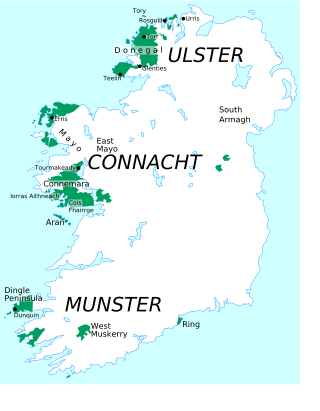Connacht Irish (Irish: Gaeilge Chonnacht) is the dialect of the Irish language spoken in the province of Connacht. Gaeltacht regions in Connacht are found in Counties Mayo (notably Tourmakeady, Achill Island and Erris) and Galway (notably in parts of Connemara and on the Aran Islands). Connacht Irish is also spoken in the Meath Gealtacht Ráth Chairn and Baile Ghib. The dialects of Irish in Connacht are extremely diverse, with the pronunciation, forms and lexicon being different even within each county.
| Connacht Irish | |
|---|---|
| Connacht Gaelic | |
| Gaeilge Chonnacht | |
| Pronunciation | Galway: [ˈɡeːlʲɟə ˌxʊn̪ˠəxt̪ˠ]Mayo: [ˈɡeːlʲɪc ˌxʊn̪ˠəxt̪ˠ] |
| Ethnicity | Irish |
Early forms | |
| Latin (Irish alphabet) Irish Braille | |
| Language codes | |
| ISO 639-1 | ga |
| ISO 639-2 | gle |
| ISO 639-3 | gle |
| Glottolog | conn1243 |
 The three dialects of Irish. Connacht's speakers are spread from Galway and Mayo to Meath. | |

The Irish of South Connemara is often considered the "standard" Connacht Irish owing to the number of speakers however it is unique within Connacht and has a lot more idiomatic connection to extinct dialects in North Clare (for example "acab" instead of "acu" in the rest of Connacht). Words such as dubh and snámh tend to be pronounced with a Munster accent in South Connemara whereas in Joyce Country, Galway City and Mayo they are pronounced with the Ulster pronunciation. In addition to this the standard in Connacht would be to pronounce the words leo and dóibh as "leofa" and "dófa" however in South Connemara and Aran they are pronounced "leothab" and "dóib". Lexical and pronunciation differences exist within Mayo with Tourmakeady featuring an "í" sound in vowel endings much more commonly. In addition to this the lexicon of Dún Chaocháin to the east of Belmullet tends to be far more Ulster influenced than that of Eachléim (murlas vs ronnach) and there is a huge Ulster influence on the dialect of North Mayo in general owing to historic migration. The Irish of Eachréidh na Gaillimhe and Dúiche Sheoigheach tend to share more phonetic commonalities with neighbouring Mayo than with South Connemara
Documented sub-dialects include those of Cois Fharraige[a] and Conamara Theas,[b] both of which are in Galway, and Erris in Mayo.
Lexicon
Some differences between Mayo and Galway are seen in the lexicon:
| Mayo | Galway | Gloss |
|---|---|---|
| Cluinim / Cloisim / Moithím / Airím | Cloisim | I hear |
| Doiligh | Deacair | Difficult |
| Úr | Nua | New |
| Nimhneach | Tinn | Sore |
Some words used in Connacht Irish that are not found in other dialects include:[1]
| Connacht | Standard | Gloss |
|---|---|---|
| Cas | Buail, Bualadh | Meet, uses verbal noun of casadh |
| Gasúr | - | Young child; Mayo, Munster & Ulster: Young boy |
| Cisteanach / Cistinidh | Munster: Cistin | Kitchen |
Variant spellings include:
| Connacht | Standard | Gloss |
|---|---|---|
| Tíocht | Teacht | verbal noun of tar: To come |
| Aríst | Arís | Again |
| Caiptín | Captaen | Captain |
| Col ceathrar | Col ceathrair | Cousin |
| Feilm, Feilméar | Feirm, Feirmeoir | Farm, Farmer |
| Ariamh / Iriamh | Riamh | Ever / Never |
Variants distinctive of, but not unique to Connacht include:
- fata, fataí, "potato", "potatoes"
- fuisce, "whiskey"
- muid, emphatic form muide/muidí for the first person plural pronoun, Ulster Irish uses this form as well, whereas Munster Irish uses sinn, sinne although sinn, sinne are used in Mayo, particularly in the Erris dialect.
- chuile, "every" (contraction of gach + uile)
Phonology
The phonemic inventory of Connacht Irish (based on the Tourmakeady accent[2]) is as shown in the following chart (see International Phonetic Alphabet for an explanation of the symbols). Symbols appearing in the upper half of each row are velarized (traditionally called "broad" consonants) while those in the bottom half are palatalized ("slender"). The consonant /h/ is neither broad nor slender.
| Consonant phonemes | Labial | Coronal | Dorsal | Glottal | ||||||||||||||
|---|---|---|---|---|---|---|---|---|---|---|---|---|---|---|---|---|---|---|
| Bilabial | Labio- dental | Labio- velar | Dental | Alveolar | Alveolo- palatal | Palatal | Velar | |||||||||||
| Plosive | pˠ pʲ | bˠ bʲ | t̪ˠ | d̪ˠ | tʲ | dʲ | c | ɟ | k | ɡ | ||||||||
| Fricative/ Approximant | fˠ fʲ | vʲ | w | sˠ | ʃ | ç | j | x | ɣ | h | ||||||||
| Nasal | mˠ mʲ | n̪ˠ | nˠ nʲ | n̠ʲ | ɲ | ŋ | ||||||||||||
| Tap | ɾˠ ɾʲ | |||||||||||||||||
| Lateral approximant | l̪ˠ | lˠ lʲ | l̠ʲ | |||||||||||||||
The vowels of Connacht Irish are as shown on the following chart. These positions are only approximate, as vowels are strongly influenced by the palatalization and velarization of surrounding consonants.

In addition, Connacht has the diphthongs /iə, uə, əi, əu/.
Some characteristics of Connacht that distinguish it from the other dialects are:
- In some varieties, vowel lengthening before word-internal clusters of voiced plosive + liquid (e.g. /ɑːɡləʃ/ eaglais "church")
- In some varieties (e.g. in Erris Irish (County Mayo)[3] and, as seen in the table above, in Tourmakeady) a four-way distinction among coronal nasals and laterals: /n̪ˠ ~ nˠ ~ nʲ ~ n̠ʲ/, /l̪ˠ ~ lˠ ~ lʲ ~ l̠ʲ/, often without lengthening of orthographic short vowels before them.
- In the variety spoken in Cois Fharraige (the area along the north shore of Galway Bay between Barna and Casla), underlying short /a/ is realized as a long front [aː] while underlying long /aː/ is realized as a back [ɑː].
- /n/ is realized as [ɾ] (or is replaced by /ɾ/) after consonants other than [s]. This happens in Ulster as well.
- Broad bh is rendered /w/ even in initial positions, with a few exceptions.
- The inflected pronouns agam, agat and againn are usually reduced into monosyllables /amˠ/, /adˠ/, /an̠ʲ/.
- The prepositions do, de are both realised as [gə] and their inflected forms are frequently pronounced (and sometimes written) in their lenited forms.
- The preposition-article compound sa (i + an "in the") causes eclipsis, where it causes lenition in the Caighdeán and in the other dialects.
Morphology
Nouns
In some dialects of Connacht the plural endings -anna and -acha are always replaced by -annaí and -achaí. It is also common in many Gaelic-speaking areas of Connemara that the dative singular form of all 2nd declension nouns has been generally adopted as the nominative, giving these nouns the typical ending in palatalized consonants in the nominative singular. This is indicated in the spelling by the letter i before the final consonant.
| Connemara form | Standard form | Gloss |
|---|---|---|
| -achaí, -annaí | -acha, -anna | Plural ending |
| bróig | bróg | Shoe |
| ceird | ceard | Craft |
| cluais | cluas | Ear |
| cois | cos | Foot, Leg |
| láimh | lámh | Hand |
Verbs
Irish conjugation is characterized by having a mixture of synthetic forms (an fhoirm tháite), which provide information about person and number in the verb ending, and analytic forms (an fhoirm scartha), which require the addition of a pronoun. In Galway and Mayo, as in Ulster, the analytic forms are used in a variety of forms where the standard language has synthetic forms, e.g. molann muid "we praise" (standard molaimid) or mholfadh siad "they would praise" (standard mholfaidís). However, the synthetic forms, including those no longer included in the standard language, may be used in answering questions.
| Connemara | Standard | Gloss |
|---|---|---|
| Díonaim | Déanaim | I make/do |
| Íosaim | Ithim | I eat |
Connacht Irish favours the interrogative pronoun cén and forms based on it such as cén uair, "when" instead of Munster cathain, or céard instead of Munster/Ulster cad. Relative forms of the verb such as beas for beidh, "will be", or déananns/déanas, "do", for déanann are frequently used.
Notable speakers
Some notable Irish singers who sing songs in the Connacht Irish dialect include Seosamh Ó hÉanaí, MacDara O Conaola, Darach Ó Catháin, Seán Mac Donncha and Máire Áine Ní Dhonnchadha.
Notes
References
Bibliography
Literature
Music
- Ní Fhátharta, Celia (2010). Irish Traditional Sean-Nós Songs (CD). Inverin: Cló Iar-Chonnacht.
- Ó Fátharta, Meaití Jó Shéamuis (2003). Bóithríní an Locháin: Sean-Nós Songs from Connemara (CD). Inverin: Cló Iar-Chonnacht.
External links
